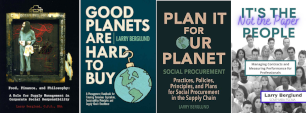When buying goods and services, equipment for businesses and government, and on any construction and infrastructure projects, a social procurement approach is one that would take into consideration the interests of the community stakeholders. This approach includes: social, ecological, environmental and economic development. Best value is achieved when we balance value-based interests along with pricing concerns.
When tendering a project with social procurement values, whether a domestic or a foreign contractor takes the contract, it creates positive competitive tension in the market. Social procurement values ensure social impact in communities once the project is initiated. Social impact is a measurable change on social issues or outcomes through procurement decisions. Social procurement is the transition from making goods deals, to making deals that do good.
Social procurement values have been around for a couple of decades but are receiving more attention through their success. Every organization consumes goods and services and these transactions are the everyday means of commerce. Social procurement is a specific strategy to ensure that local economic benefits are realized when contracting for goods or services.
Labour is an important factor in social impact outcomes. Individuals facing barriers, as one example, are often overlooked as a first choice for employment with for-profit organizations. This is understandable where peak efficiency is required to sustain profits. The result is many people facing employment barriers such as individuals having disabilities–rely more on social services paid for by taxpayers.
Would your organization hire an ex-convict? Likely not. However, Purpose Construction out of Winnipeg, does. As a social enterprise, Purpose Construction trains barriered individuals to qualify for construction work, pays them living wage rates, and helps them to return to full time work–often in the private sector. Social enterprises are social purpose businesses which generate value by providing goods and services-generally as a not-for-profit operation. Social enterprises provide meaningful work for people facing barriers to employment. This can include skills development to prepare the individuals for a return to the work force. Social enterprises work with government, private sector companies and with other social enterprises. Social enterprises are operated by business entrepreneurs.
The Purpose Construction example builds social capital in a community. Buy Social Canada defines social capital as the “relationships and networks within and among community members.” With a shortage of skilled trades, Purpose Construction can build a pool of workers to meet the demand in the market without government subsidies.
One of the early and continuing success stories in the social enterprise sector, is CleanStart Hoarding & Junk Removal CCC Inc. In the Vancouver lower mainland, CleanStart, in 2015, paid $233,000 in wages to its barriered employees. This resulted in a social return on investment (SROI) of $1M per year in the local economy. In 2020, CleanStart will contribute $1.4M. The SROI is based on a study by E&Y with Atira Property Management which shows that for every dollar paid to target employees, the return is >$4.00 in social and economic development! When was the last time you got a 4 to 1 return on an investment?
As a synopsis, the empirical study on the SROI demonstrated reduced reliance on social subsidies, reduced shelter costs, reduced criminal activities, taxes being paid back into community, increased local spending, increased employability, increased self-esteem, improved health and general quality of life. This moves these individuals from dependency on social services to independent taxpayers.
Another company which uses social procurement as a business strategy is Chandos Construction. They are the first and largest B Corp certified commercial builder.
Chandos is a Canadian, employee owned construction company operating in several major Canadian cities. Their social procurement strategy embraces: local employment, expanded diversity, poverty reduction, eliminating social isolation, local purchasing, skills training, first source hiring, and fair wages to underrepresented individuals. Chandos successfully responds to tenders for major infrastructure projects-which is a very competitive sector. Their commitment to social procurement values is another example of building social capital. Chandos recently brought on several workers facing barriers as full-time employees and enrolled them in the Red Seal training program for trades.
Purpose Construction, CleanStart and Chandos are great examples of social procurement being applied in Canada. It takes the spending power of buyers to make this happen. It also requires that buyers look beyond the lowest out-of-pocket cost and redefine the value proposition. As we move into the post-COVID era, it is even more important that we ensure that social enterprises and small medium businesses have a good opportunity to participate in government contracts. Government contracts are taxpayer paid. While we are engaged in a global economy, we concurrently need local economic diversity.
This implies not simply putting the bids on e-bidding platforms but using strategies which will increase the number of bidders. One tool is the unbundling of large contracts. The theory has been to buy the most from least to get the lowest unit cost. This strategy will always favour the multi-national corporations with the deeper pockets. Unbundling could take a percentage of the requirements and ensure local participation for the supply. i.e. targeting women-owned businesses or Indigenous contractors. The balance of the requirements goes to the lowest bidder.
We are dealing with many oligopolistic markets where the largest suppliers tend to control the pricing and availability. When we reflect on the PPE shortage during COVID, in part, this can be attributed to the bundling of the demand. Great pricing but as it turned out-no supply.
All trade agreements, international and domestic, provide for exceptions, exemptions, and exclusions when dealing with social enterprises by Federal, Provincial or Municipal governments. Further regional trade agreements provide for derogations for economic development strategies!
Community benefit agreements are an extension of the social procurement strategy. A CBA is an agreement between community, government, and developers that ensures development projects enhance local social, environmental and economic opportunities. The Parq Casino in Vancouver is a good example of CBA.
For the past 2-years, through Presentations Plus, I have been the procurement advisor on the Coastal Communities Social Procurement Initiative (CCSPI) on Vancouver Island. Along with Buy Social Canada, Scale Collaborative, and the Vancouver Island Construction Assoc., our role is informing public officials, training public buyers, training small businesses and social enterprises on social procurement strategies. This includes drafting bid document templates with social value language which focuses on increasing local opportunities and drafting policies. CCSPI began with 6 cities/towns and now has 20+ communities participating in this project. It’s very exciting to see the commitment from so many parties to common goals which are being realized.
The following table shows the difference from where procurement has focused its attention and the transition to social procurement values.
|
Traditional focus |
Social focus |
|
Short-term costs |
Long-term investment |
|
Inputs |
Outcomes |
|
Fiscal interests |
Community interests |
|
Consumption of resources |
Conservation of resources |
|
Make good deals |
Make deals that do good |
|
Follow |
Lead |
|
Ethic of Justice |
Ethic of Care |
It may be early days in social procurement, but I am pleased to say that more and more progressive organizations are adopting this strategy because of the compelling business case it creates. It’s about being vocal when making local the focal!



